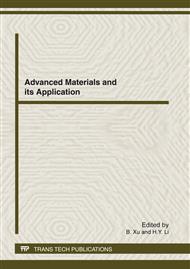p.214
p.218
p.222
p.226
p.230
p.236
p.240
p.244
p.249
Axisymmetric Finite-Element Analysis for Interface Migration-Controlled Shape Instabilities of Plate-Like Double-Crystal Grains
Abstract:
An axisymmetric finite-element method is developed to predict the evolution behavior of microstructures by interface migration. The formulation of the method is conducted on the basis of the energy principle during the interface motion. The computations extend earlier models by accounting in detail for the effects of grain-boundary energy, surface energy and chemical potential difference. The eventual shape of the plate-like double-crystal grain depends on both the initial β and the thermal grooving angle Ψ. For a given β, a critical Ψc exists. When Ψ>Ψc, the eventual shape is one made of two sphere segments with a thermal groove. When Ψ≤Ψc, grain splitting along the grain boundary occurs, and the splitting segments evolve into two spheres, respectively. Both the spheroidization time and the splitting time increase with Ψ and β increasing. The volume shrinkage rate decreases with increasing Ψ.
Info:
Periodical:
Pages:
230-235
Citation:
Online since:
February 2012
Authors:
Price:
Сopyright:
© 2012 Trans Tech Publications Ltd. All Rights Reserved
Share:
Citation:


